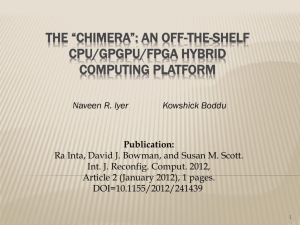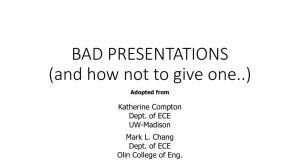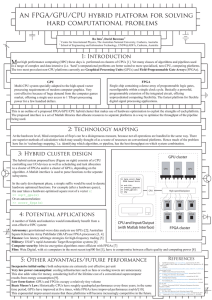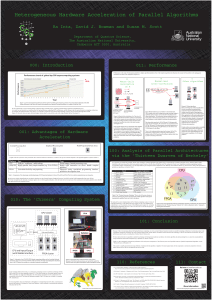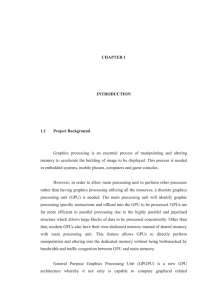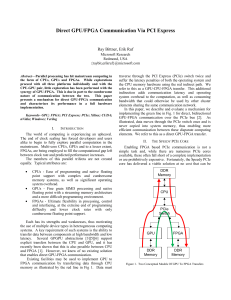Acceleration of parallel algorithms using a heterogeneous computing system Ra Inta,
advertisement
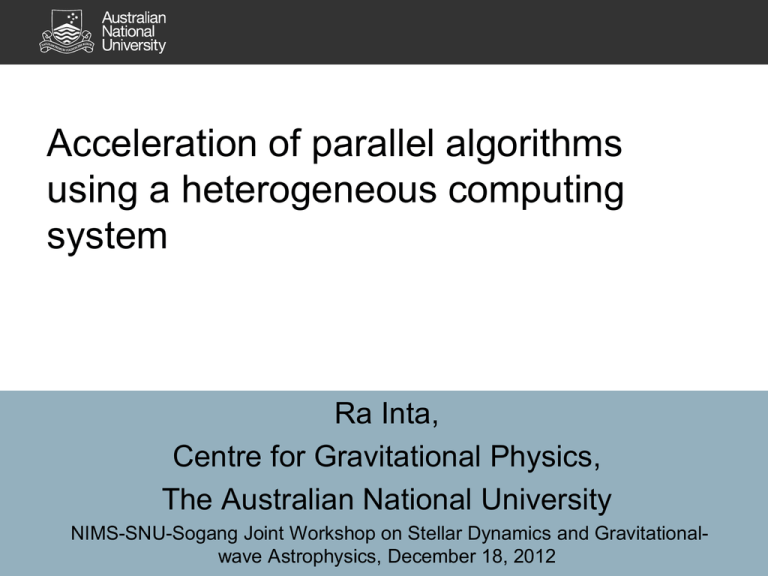
Acceleration of parallel algorithms using a heterogeneous computing system Ra Inta, Centre for Gravitational Physics, The Australian National University NIMS-SNU-Sogang Joint Workshop on Stellar Dynamics and Gravitationalwave Astrophysics, December 18, 2012 Overview 1. 2. 3. 4. 5. 6. 7. Why a new computing architecture? Hardware accelerators The Chimera project Performance Analysis via Berkeley’s ‘Thirteen Dwaves’ Issues and future work Conclusion 2 Why do we need new computing architectures? • • • • We live in an increasingly data-driven age LHC experiment alone: data rate of 1 PB/s Many data-hungry projects coming on-line Computationally limited (most LIGO/Virgo CW searches have computation bounds) 3 Demand side… (adapted from www.top500.com , August 2012) 4 …supply side • Intel discontinued 4GHz chip • Speed walls • Power walls • Moore’s Law still holds, but for multicore 5 Time for a change in high performance computing? • Focus on throughput, rather than raw flop/s (e.g. Condor on LSC clusters) • Focus on power efficiency (top500 ‘Green list’) 6 Hardware acceleration • Response to computational demand • Two most common types: Graphical Processor Unit (GPU) and Field Programmable Gate Array (FPGA) 7 The Graphical Processor Unit • Subsidised by gamers • Most common accelerator • Excellent support (nVidia) 8 The Field Programmable Gate Array Programmable hardware (‘gateware’) replacement for application-specific integrated circuits (ASICs) 9 Cultural differences • GPUs: software developers • FPGAs: hardware, electronic engineers FPGA development is a lot less like traditional microprocessor programming! (VHDL, Verilog) 10 Platform Pros CPU GPU FPGA Analysis ‘workhorse,’ multi-tasking Highly parallel, fairly simple interface (e.g. C for CUDA) Unrivalled flexibility and pipelining Cons Power hungry, limited processing cores Highly rigid instruction set (don’t handle complex pipelines) Expensive outlay, specialised programming interface, prohibitive development time 11 Choosing the right hardware Highly algorithm dependent, e.g. • Dense linear algebra: GPU • Logic-intensive operations: FPGA • Pipelining: FPGA 12 The ‘Chimera’ project • Appropriately(?) combine benefits of three hardware classes • Commercial, off the shelf (COTS) components • Focus on high throughput, energy efficiency (Image: E. Koehn) 13 Initial design PCI Express COTS constraints 14 Subsystem Vendor Model CPU Intel i7 Hexacore GPGPU nVidia Tesla C2075 FPGA Altera Stratix-IV 15 16 Performance 17 (32-bit integer (x, y) pairs) Throughput: • FPGA alone: 24 ×109 samp/s • GPU alone: 2.1×109 samp/s • CPU alone: 10 ×106 samp/s Surprising! • FPGA pipeline was highly optimised • Expect GPU to perform better with more complicated (floating point) integration problems • Expect CPU to have even worse performance 18 • image processing • synthetic aperture arrays (SKA, VLBA) • video compression 19 Searched 1024×768 pixel image (16-bit greyscale) for a 8×8 template • Numerator GPU, 158 frame/s • Denominator GPU: 894 frame/s FPGA: 12,500 frame/s So much for a Graphical Processor Unit! Best combination: GPU + FPGA 20 • Data analysis • Interface GPUs with experimental FPGA DAQ systems (GMT, quantum cryptography) R. Inta, D. J. Bowman, and S. M. Scott, “The ‘Chimera’: An Off-The-Shelf CPU/GPGPU/FPGA Hybrid Computing Platform,” Int. J. Reconfigurable Comp., 2012(241439), 10 pp. (2012) 21 The Thirteen Dwarves of Berkeley • Phillip Colella identified 7 classes of parallel algorithms (2004) • A dwarf: “an algorithmic method encapsulating a pattern of computation and/or communication” • UC Berkeley CS Dept. increased to 13 K. Asanovic and U C Berkeley Computer Science Department, “The landscape of parallel computing research: a view from Berkeley,” Tech. Rep. UCB/EECS-2006183, UC Berkeley (2005) 22 Dwarf 1 Dense Matrix 2 3 4 5 6 7 8 9 10 Sparse Matrix Spectral N-Body Structured Grid Unstructured Grid MapReduce Combinational Logic Graph traversal Dynamic Programming Backtrack/Branch-and11 Bound 12 Graphical Models 13 Finite State Machine Examples/Applications Linear algebra (dense matrices) Linear algebra (sparse matrices) FFT-based methods Particle-particle interactions Fluid dynamics, meteorology Adaptive mesh FEM Monte Carlo integration Logic gates (e.g. Toffoli gates) Searching, selection ‘Tower of Hanoi’ problem Global optimization Probabilistic networks TTL counter 23 *Fixed point ^Floating point 24 Issues/future work • • • • • Kernel module development Scalability is problem-size dependent FPGA development is labour-intensive Pipeline development GW data analysis! 25 Issues/future work 26 Issues/future work • • • • • Kernel module development Scalability is problem-size dependent FPGA development is labour-intensive Pipeline development GW data analysis! 27 Conclusion • We are in a transition period for HPC architecture • Can exploit highly heterogeneous, COTS, hardware accelerators for certain algorithms • Powerful and energy efficient • Requires further development More information: www.anu.edu.au/physics/cgp/Research/chimera.html 28 Thanks to NIMS and Seoul National University! • Dr Sang Hoon Oh • Dr John J. Oh 29 Thanks for listening! Ra.Inta@anu.edu.au 30






